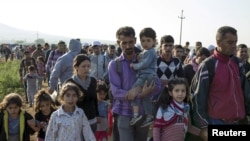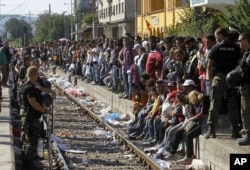The U.N. High Commissioner for Refugees says nearly 300,000 refugees and migrants have arrived in Europe across the Mediterranean Sea this year. Most went to Italy and Greece. The UNHCR warns the situation is not sustainable and is calling for a comprehensive solution.
The U.N. refugee agency says the chaotic scenes of thousands of desperate people trying to enter the former Yugoslav Republic of Macedonia over the weekend has calmed. But, it warns the flight of these desperate people is continuing and is unstoppable.
UNHCR spokeswoman Melissa Fleming says people are coming in groups of 300 to 400 people. Monitors at the Macedonian border say up to 3,000 asylum seekers are arriving every day — most fleeing violence and conflict in Syria, Afghanistan and Iraq.
Fleming says the refugees and migrants — among them many vulnerable women, children, and elderly — are in very poor condition when they arrive.
“They are often physically exhausted," said Fleming. "They are psychologically traumatized and very often in need of humanitarian medical assistance… So, it is vital that these people are treated humanely. Also, that essential assistance is provided.”
Once they have rested, the refugees and migrants head for Serbia, cross into Hungary and move on to other countries in the European Union. The UNHCR reports Germany and Sweden accept around 43 percent of the asylum seekers. Germany recently said it expected around 800,000 to arrive this year.
Fleming says this situation is not sustainable and cannot be solved by any one country working alone. She says there has to be a more decent and equitable distribution of these desperate people among the 28-member European Union.
She tells VOA a recent plan by EU member-countries to redistribute 40,000 refugees among EU member countries has yet to be implemented. While this will not solve the problem, she says it is a good beginning.
Asylum claims
Fleming adds the Dublin agreement, which sets out rules for examining asylum claims, also has some measures, which allow for better distribution. But, they are not being implemented properly.
“That is, if someone claims asylum in one country, but has strong ties to another," said Fleming. "Many people seeking asylum are headed for countries in which they have ties. Either they have family members or they speak the language. There are communities where a transfer of their applications could take place. So, that could be strengthened.”
The UNHCR is calling for legal avenues, such as more resettlement opportunities and more student and work visas so people do not have to undertake these perilous journeys.












